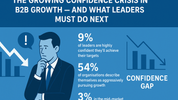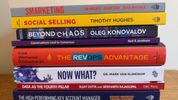In part 1 of this blog, I explained the research that have made by Matthew Dixon and Ted McKenna's new book "the jolt effect".
There is a series of blogs around the book, which looks at research around deals where "nothing" happens.
You put in a load of sales time and resource and the client ends up ghosting you and or doing nothing.
Part 1 of my blog can be found here
How do we win deals where the client "does nothing"?
Part 2 of my blog can be found here
How can you qualify out deals where prospects end up making a "do nothing" decision?
In this blog I talk about how to qualify deals for the tell tell signs that your deal will end up as "do nothing". Things clients will say, things prospects will do or ask for.
Part 3 of my blog, which can be found here
In this blog I explain, how the default playbook we use when a client makes "no decision" does not work in 56% of cases. See diagram below.

How you can turn a "no decision" into a "decision".
Matt Dixon, calls it the "Jolt Effect" in his book of the same name.
What he recommends is that you need to elevate yourself from being "just another salesperson" to having a "personal brand". You need to be positioned very differently.
Matt recommends
1. Can the customer decide? We need to qualify our customers not just as the "ability to buy" and having the authority to buy" but do they have the "ability to decide"? I used to work for a US software house that was at the "premium end of the market" and we rarely did deals in owner owned companies. As they were pretty much taking money out of their pocket to buy. We did business in public listed businesses as it wasn't the employees money.
2. You offer your recommendations. Don't start doing discovery and needs analysis, tell them what you would do if you were them. The client is looking for guidance.
"These are all good options, but personally, here's what I would do if I was you"
3. Limit the exploration. Many sales people when they see indecision, they start throwing white papers and case studies, this just causes indecision. There is a saying "less is more".
4. Take risk of the table. Such as opt-outs, refunds, additional professional services and by putting in clear project plans.
"I've mapped out the first three months of the project and where we are going to get some quick wins".
Or recommend you start small.
Our recommendation is that this is crying out to get your salespeople on social. Having a buyer centric profile, so a profile that shows you are an expert. Having a wide and varied network where it's clear you know all the right people, that can influence this person, both in the organisation and outside the organisation. Plus publishing content, not brochures, but content that shows you are an expert. A person just like the buyer.
If you want to implement the "jolt effect" you must get social as well!
Want to know more about social selling, check out my new book
"social selling techniques to influence buyers and changemakers - 2nd edition".
In this brand new edition, I have updated all the text, I have also got 15 practitioners, so people who are doing this already to explain how they are get (practical) business benefit. From the CEO that has been running a digital business for over 18 months to sales leaders who use social selling every day.
Articles on how these business have and are implementing digital, from Mercer, Telstra Purple, Ring Central, Cyberhawk, Namos, Ericsson, Crux Consulting, DLA Ignite and more.
What does Mark Schaefer, Marketing guru think of the book "social selling - techniques to influence buyers and changemakers - 2nd edition"? watch the video here
It's available on Amazon worldwide. Link to Amazon.com here and Amazon.co.uk here.

 unknownx500
unknownx500











